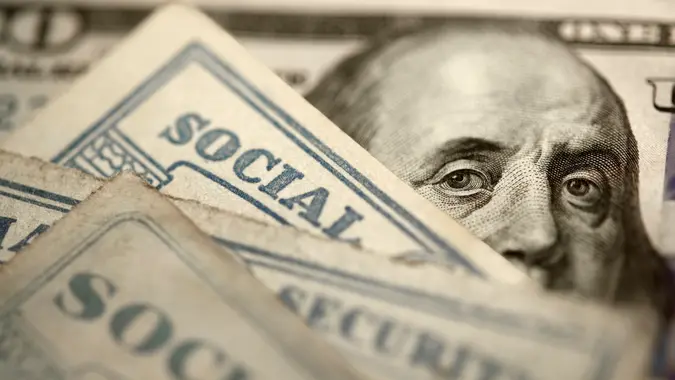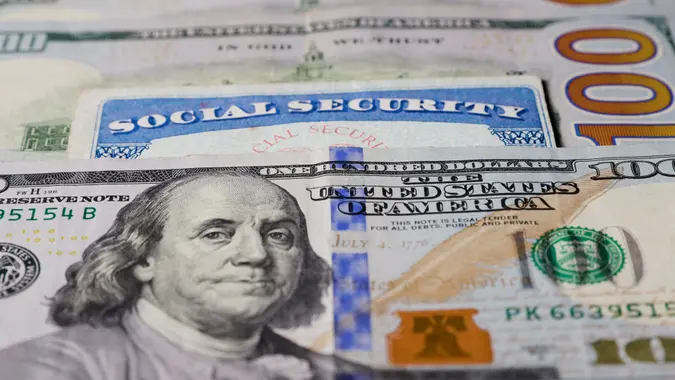Tony Robbins: 5 Retirement Planning Tips He Swears By

Commitment to Our Readers
GOBankingRates' editorial team is committed to bringing you unbiased reviews and information. We use data-driven methodologies to evaluate financial products and services - our reviews and ratings are not influenced by advertisers. You can read more about our editorial guidelines and our products and services review methodology.

20 Years
Helping You Live Richer

Reviewed
by Experts

Trusted by
Millions of Readers
Life coach, entrepreneur and business strategist Tony Robbins is known for his high-energy self-development seminars and for pushing countless people to reach their personal and professional goals. Even though he started out making only $40 a week as a janitor in Los Angeles, Robbins learned to turn his humble beginnings into an empire worth hundreds of millions
“I think if you can find a place where you can do something that gives you freedom and gives you a chance to really take control of your own time, it leads toward the idea of maybe owning your own business,” Robbins said.
Today, Robbins has a net worth of an estimated $600 million and also helps get people on track as they approach retirement age and achieve financial freedom. Here are five tips he recommends to help you increase and maintain your retirement income.
Be Careful of Hidden 401(k) Fees
Though you are cautious about looking for hidden fees with credit cards, you often aren’t as diligent when retirement planning. However, while many people rely on 401(k) accounts for retirement, Robbins cautions about the existence of hidden fees that can significantly impact your savings. Understanding these fees is crucial for your financial empowerment.
In a blog post on his website, he wrote, “Eight out of ten Americans don’t know the cost of their plan — and 67% believe they’re not paying anything. Nothing could be further from the truth!”
He continued, “The 401(k) industry did not have to reveal how much it was charging consumers. Now that they do, thanks to new legislature around disclosure, they’ve simply created 50-page documents that are so opaque it would take a Ph.D (and a boatload of patience) to understand.
“Within these ‘disclosure’ agreements, there are as many as 17 different additional charges that are not outright called ‘fees.'”
Understand Taxes in Retirement
It’s a common misconception that social security benefits and retirement accounts are not taxable. Many people are surprised to learn that a large portion of their nest egg can go to taxes if not planned carefully.
“While millions of Americans have a retirement account in place, the scary truth is, they have not considered the impact of taxes in retirement,” Robbins stated in another blog post. “And taxes are vital — they determine how much of your money you will actually keep.”
He noted, “Your retirement tax planning must go beyond maximizing your 401(k) or IRA contributions. You need to learn about the different types of retirement savings accounts and the pros and cons of each. Don’t get to retirement only to find out that a huge chunk of your life savings will go to taxes.”
Accurately Calculate How Much You Need for Retirement
How much to save for retirement is one of the most common questions people have. So, whether you are age 50 or age 62, there are many things to consider, such as lifestyle, healthcare costs, everyday expenses, housing, long-term care and more.
“This number isn’t what you earn, it’s what you spend on a normal basis,” Robbins explained. “If you spend more than you make, use that number — but you need to figure out how to reverse that practice! For example, if you make $80,000 a year but live off $70,000, your number would be $70,000.”
According to Robbins, you then multiply that number by 20. “This is a rough idea of how much you’ll need to maintain your current lifestyle through retirement.”
Pay Down Debt Before Investing
Whether it’s credit card bills or student loans, before investing for retirement, Robbins recommends paying down debt first.
“Are you realistic about your current financial situation?” he asked in a blog. “Anyone can invest a percentage of their paycheck in a 401K or IRA. But if you’re wondering how to invest money to make money quickly or thinking about a higher-risk area, make sure you first pay down debt and have a good idea of your cash flow and budget.”
Pay Yourself First
Another financial tip Robbins swears by is setting aside a small amount of your paycheck.
“Track how much you earn and spend in a month, and pick a percentage of your income to set aside, ideally no less than 10%, but as high as you can go,” he wrote.
“Save as much as you can because that number will increase as your income grows. This amount is off the top and doesn’t factor into other spending. Other expenses, such as housing costs, utility bills and restaurant meals, come next.”
Caitlyn Moorhead contributed to the reporting for this article.
More From GOBankingRates
 Written by
Written by  Edited by
Edited by 

























